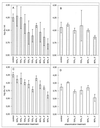A technique To quantify the population size and composition of the biofilm component in communities of bacteria in the phyllosphere
- PMID: 9835563
- PMCID: PMC90923
- DOI: 10.1128/AEM.64.12.4789-4795.1998
A technique To quantify the population size and composition of the biofilm component in communities of bacteria in the phyllosphere
Abstract
The presence of microbial biofilms in the phyllosphere of terrestrial plants has recently been demonstrated, but few techniques to study biofilms associated with living plant tissues are available. Here we report a technique to estimate the proportion of the bacterial population on leaves that is assembled in biofilms and to quantitatively isolate bacteria from the biofilm and nonbiofilm (solitary) components of phyllosphere microbial communities. This technique is based on removal of bacteria from leaves by gentle washing, separation of biofilm and solitary bacteria by filtration, and disintegration of biofilms by ultrasonication. The filters used for this technique were evaluated for their nonspecific retention rates of solitary bacteria and for the efficiency of filtration for different concentrations of solitary bacteria in the presence of biofilms and other particles. The lethality and efficiency of disintegration of the sonication conditions used here were also evaluated. Isolation and quantification of bacteria by this technique is based on use of culture media. However, oligonucleotide probes, sera, or epifluorescent stains could also be used for direct characterization of the biofilm and solitary bacteria in the suspensions generated by this technique. Preliminary results from estimates of biofilm abundance in phyllosphere communities show that bacteria in biofilms constitute between about 10 and 40% of the total bacterial population on broad-leaf endive and parsley leaves.
Figures



References
-
- Brading M G, Boyle J, Lappin-Scott H M. Biofilm formation in laminar flow using Pseudomonas fluorescens EX101. J Ind Microbiol. 1995;15:297–304.
-
- Costerton J W, Cheng K, Geesey J G, Ladd G T, Nickel I J, Dasgupta C M, Marrie T J. Bacterial biofilms in nature and disease. Annu Rev Microbiol. 1987;41:435–464. - PubMed
-
- Costerton J W, Lewandowski Z, Caldwell D E, Korber D R, Lappin-Scott H M. Microbial biofilms. Annu Rev Microbiol. 1995;49:711–745. - PubMed
-
- Delaquis P J, Caldwell D E, Lawrence J R, McCurdy A R. Detachment of Pseudomonas fluorescens from biofilms on glass surfaces in response to nutrient stress. Microb Ecol. 1989;18:199–210. - PubMed
LinkOut - more resources
Full Text Sources

